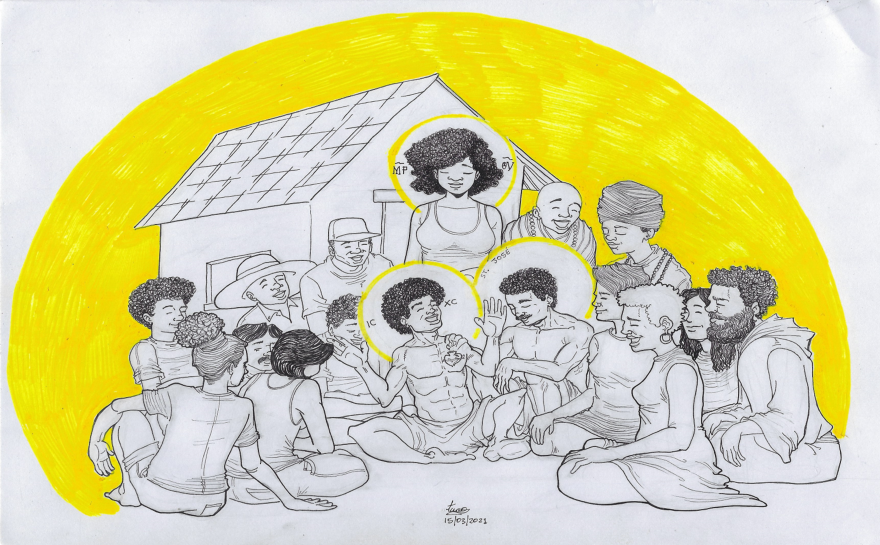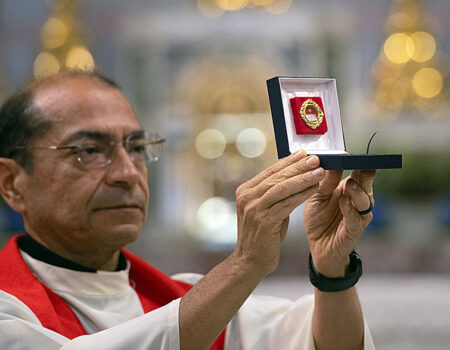SAINT JOSEPH and the “friends of Heart of Jesus”
Tuesday August 17, 2021

March, 2021
It is likely that you, being part of the Chevalier Family, have at some time in your life heard in our prayers the invocation “Saint Joseph, model and patron of the friends of the Heart of Jesus, pray for us!” This is something very ancient and quite widespread among us. However, when praying it, we may ask ourselves: Does it still make sense to use this invocation today?
Well, my intention here is not to make an academic study of the subject. I would like simply to share a reflection on this important aspect of our spirituality that is the devotion to St. Joseph and the relevance of invoking him as patron of the “friends of the Heart of Jesus”. With this in mind, let us now make a brief visit to our sources, that is, to study what our Founder has written about St Jospeh.
St Joseph and the “Little Society” of the MSC
In the first place, it is important to note that the invocation “St Joseph, model and patron of the friends of the Heart of Jesus” goes back directly to Fr Chevalier. His book, “Le Sacré-Coeur de Jésus”, testifies to this. There we see that in September 1855, on the occasion of the installation and blessing of our first chapel (which was an abandoned stable), a question arose in the heart of our founder: “under what title may we invoke Saint Joseph in this sacred place, all dedicated to the Heart of Jesus?” After much prayer and reflection, the idea came to mind of giving the father of Jesus the title of “Saint Joseph, friend of the Sacred Heart”.
In fact, Fr Chevalier followed his intuition and began to call St Joseph “friend of the Heart of Jesus”. After a while, however, as he wished to use this title publicly, it was necessary to submit this invocation to the judgement of the Holy Office, as had been done with the title of “Our Lady of the Sacred Heart”. However, the Holy See replied that to be “friend of the Heart of Jesus” did not appear to be a sufficiently glorious title for the Spouse of Mary. Thus an alteration was made, so that St. Joseph could be invoked as “Example and Patron of the Friends of the Heart of Jesus”. Two years after the inauguration of that little “Church-stable” of which we have just spoken, there occurred another event which highlights the relationship of trust that our Founder had with St Joseph. It happened that one morning on their way to their stable- church they found part of the building had collapsed. And it was precisely the side where the altar of St Joseph stood. As they had no means of repairing the damage, Chevalier turned to the image of the Saint among the rubble and said to him: “The disaster happened on your side. So it is you who will have to repair it!” Before long, a benefactor came forward to repair the little church. This made our founder redouble the confidence he already had in the head of the Holy Family.
Further evidence could be cited, but I believe that this is enough to give us an idea of the esteem in which Chevalier held St Joseph. Being a founder, he wanted to communicate this same devotion to his religious family. Witness to this are the first “Rules” (1855 and 1857) in which he presents St Joseph as “depository and faithful guardian of the Sacred Hearts of Jesus and Mary”, the “Formula Instituti” (1869) and the Constitutions of 1877, in which one can read: ” the Congregation will place its houses now and in the future under the protrction of this illustrious patron; therefore it will always acknowledge him as their Owner and Provider.”
A “spirituality of the heart” in the style of Joseph?
After Vatican Council II, in the wake of the promulgation of the decree Perfectae Caritatis, the Consecrated Life experienced an intense movement back to the sources. Each Institute began the process of seeking to rediscover the reasons for its existence and to carry out an “aggiornamento” of its way of being and acting in the Church. It was something similar to the process done by art restorers, who, on receiving a painting that has been repainted many times, go on scraping away layer by layer until they arrive at the original design.
It was no different with us. In the spirit of the Council, many confreres have seriously dedicated themselves to this work, and from this effort have come excellent reflections which have borne fruit in the current text of our Constitutions and in a great number of publications on our spirituality. Of all that has been elaborated, however, I would like to highlight the valuable idea of the “Spirituality of the Heart”, so dear to E. Cuskelly, who was our Superior General during this process of conciliar renewal.
The “Spirituality of the Heart” is a way of giving new meaning to what was called for a long time the “Devotion to the Sacred Heart”. To do this it was necessary to study the texts of our founder, to try to understand the “spirit” of what was being communicated by Chevalier, so that, with this renewed understanding, it could be “translated” into a more contemporary language that would make sense in today’s world. In this way, as the writings of our founder became more and more appreciated in-depth, it was perceived that when he spoke of the “Heart of Jesus” he was not referring only to a series of devotional practices. There was something deeper in his understanding: he was referring to the contemplation of that compassionate Heart of Jesus described in the Gospels. The Heart of Jesus, therefore, for Chevalier, was not something vague and ethereal, but something very concrete and questioning. Our spirituality was about being attentive to the way Jesus ‘used’ his heart: to observe who were the people he praised, to observe with whom he sat down to eat, and also to pay attention to the behaviours and people Jesus censured. As we engage in such contemplation of the Heart of Jesus, we should ask ourselves if we are using our hearts in the way he used his. If we are not, then we need to change something. This is the “spirituality of the heart”: contemplating the heart of Christ and trying to make our heart like his.
Our spirituality, understood in this way, makes room for a practice that, besides being Christocentric, is also, so to speak, ‘evangelocentric’. It is the Heart of Christ of the Gospels that we follow. And as we put his word into practice, life becomes fuller and more beautiful, and this then motivates us to be missionaries. Now, if living the Gospel brings joy, then we go “everywhere” spreading joy! We become a fire that lights other fires, and we go out setting the world on fire, because we are disciples of the One who came “to set the earth on fire” and who wants “everything to be opened” (cf. Lk 12:49).
The “spirituality of the heart” has helped us to rediscover the Heart of Jesus in the post-conciliar period. And, faithful to our founder, we have not left our “Foundress” aside. In the same vein there has also been a rich Mariological reflection on the title of Our Lady of the Sacred Heart, which has resulted in many beautiful things.
But Saint Joseph, poor man… few remembered him.
Fortunately, Pope Francis has invited us to celebrate the Year of Saint Joseph from 8 December 2020 until 8 December 2021. And this might be a beautiful occasion for us to rediscover the place of Saint Joseph in the Spirituality of the Heart. Is this not the opportune moment to repair this gap, in fidelity to what our Founder always held dear?
At first it may seem like hard work. But, looking in the right direction, perhaps we will find a way towards a “Josephine spirituality of the heart”. You see, our founder wanted to honour St Joseph in his “relationship with the Heart of Jesus”. If we don’t have much to research about St Joseph explicitly in the Bible, we can try to look for him in what the Heart of Jesus reveals to us indirectly about him.
Since we believe in the Incarnation, that is, that Jesus became a human being like us, it is a logical conclusion to believe that he needed to be educated; after all, every human being is like that. He needed to be taught to walk, to speak, to work, etc. But in addition, as the process of educating a child goes beyond the transmission of technical skills, Jesus’ education also included, so to speak, an affective education. The way we relate to others, how we deal with our affections, our self-esteem, much of this we learn from our family. Well, if it was and is like that with all of us, it could not have been any different with God made human. Thus, it was in the home of Nazareth that the Eternal Word learned to be an affectionate person and to use his Heart…
We do not have really reliable written accounts of what it was like living in that home of Nazareth, but we can deduce what Jesus’ education was like by observing his behavior as an adult, through what the Gospels tell us.
And what is the person we find in these writings like? First of all, a man full of tenderness, who embraces children, who is capable of letting himself be touched on the feet by a woman, who accepts being sprinkled with perfume with his hand on her head, who weeps the loss of a friend without any shame. Now, all this affection lived in such a balanced way is only possible for a well-balanced person. Seeing him as an adult, we can even imagine what his childhood must have been like in that home in Nazareth. How many times would Joseph have come home tired and greeted Mary with a kiss, before Jesus’ attentive eyes? How many times would that same Joseph have laid down on the ground to play and laugh with the growing child? How many times would Jesus have slept on Joseph’s lap? All these demonstrations of affection and human respect, possible in any family, took place in Nazareth and marked Jesus forever? They were people. Normal people. Curious how, at times, we run the risk of imagining the home of Nazareth as if it were a chapel where Mary and Joseph lived in perpetual adoration of the Most Holy Child, burning incense and singing the “Tantum ergo”. To imagine a Holy Family in this way would empty the mystery of the Incarnation, which had such an impact on Chevalier.
In his public life we see Jesus sitting down to eat with anyone, without any ceremony. Why not believe that this could have been typical of his family life while growing up? I imagine the house of Nazareth always full. A poor person’s house always has room for one more. At the table there is laughter, affection; there are neighbours, relatives, friends. I can almost see the child Jesus being passed from lap to lap. He attempts his first word “abba! Everyone laughs, Joseph is moved when he hears the child calling him this. This is the life of a normal family.
In fact, the theologian Leonardo Boff, in his book “St. Joseph, the Personification of the Father”, suggest that perhaps this is the greatest contribution of Joseph in the formation of the Heart of Jesus. Christ teaches us to call God “abba”. This word, so common in the mouths of children even today, is a cry: daddy! It was the way Jesus addressed Joseph. If Jesus had not had a good experience with this word in his home, he would never have called God the “Father in heaven”, who is merciful, who does not allow the lilies of the field to lack clothing or the sparrows lack food, who makes it rain on the just and the unjust. The expression of the word ‘Abba’ on Jesus’ lips is therefore due to Joseph.
In this sense, I believe it is not wrong to say that the Gospel contains a deep but barely visible Josephine dimension. In the Gospel Joseph does not speak, but, in a certain sense, everything in the Gospel speaks of the influence of Joseph. The “friends of the Heart of Jesus
I recently had a conversation on these subjects with an old friend of mine. And I told him that in our Congregation we call St. Joseph “the example and patron of the friends of the Heart of Jesus”. His first reaction was amused: “My God, what a long name!”, but then he kept thinking and added: “Patron of the friends of the Heart of Jesus? Who are the friends of the Heart of Jesus?”. I kept silent. I found the question too profound. Then I began to reflect. I remembered the table of Nazareth, as I imagine it, I remembered the passages in the Gospel where Jesus is at table, I remembered the Pharisees who were angry because Jesus “welcomed sinners and ate with them” (Lk 15:1) and I meditated at length. I thought it important to link friendship and table-fellowship, because in general we only go out to eat with those who are our friends. So, if we want to know who Jesus’ friends are, let us see with whom he sits down to eat.
So I asked an artist of my acquaintance, Timóteo André (@__theo.art), to draw me a picture. I said to him, “in your opinion, if the Holy Family lived today, who would be Jesus’ friends?” I thought it would be interesting to take the theme back to the time when Jesus lived with his family, because there must be the beginning of Jesus’ custom of welcoming everyone to his table. The artist surprised me, then, with this drawing in which Jesus is Brazilian and black, and is sitting on the pavement in front of his house, surrounded by the poor, flanked by a “mãe-de-santo” (Afro-Brazilian religious leader), a Buddhist monk, surrounded by all those who are the victims of prejudice. Mary, the mother, stands watching them. Joseph, the father, sits down together with them, touching his son’s shoulder. He likes his Son’s friends. They are “friends of the heart” of Jesus (in Portuguese, when we want to say that someone is much loved, we say that the person is a “friend of the heart”). I stoop to look at the figure of Joseph, who is very much at ease there. If they are friends of his Son, they are friends of his too. I can see him going to get something to eat from home to share with the group, laughing at their jokes, listening to their complaints?
That is when I think of our Little Society. That is when I think of Saint Joseph, patron saint of the “friends of the heart” of Jesus. I also think of that stable that was transformed into our first chapel, I think of the barn that became our first convent. I think of Chevalier and Maugenest sweeping the chapel, cooking their own food, working like Joseph, their hearts on fire…
We are now more than 150 years old, we have walked a lot in the world, we have done a lot. But the most fundamental question I believe we should always ask ourselves is: have we been in the right places and with the right people? Are we, with St Joseph, looking after the ‘friends of the heart’ of Jesus? Is our mission everywhere really committed to being close to all those that no one wants to have as friends today?
In our time there continue to be evils, as there were at the time of Joseph and of Chevalier. Countless friends of Jesus still suffer and even die, victims of racism, xenophobia, homophobia, machismo, hunger, shootings, disease? In a world of so many wounds, Joseph invites us, MSC, to sit at the table that he himself made to welcome Jesus and his friends and at that table to give to those who feel wounded the medicine of inclusion, of love, of attention, just as the Heart of Jesus has always done. Joseph invites us to be on the right side of history, on the side of God’s preferred ones, of the poor, of the excluded. Missionaries of the Sacred Heart, we announce this human, friendly and accessible Jesus. May it never occur to us to get lost on the way, to make wrong choices and end up sitting at Herod’s banquet table, whose only dish, it is said, contained the head of a poor decapitated prophet. The God of those who sit at Herod’s table is akin to Herod himself. Our table is different! It is the table of the carpenter, the table of laughter, of inclusion, of shared love. It is the table of the human and neighbourly God, the table of God-Love.
It is with all this in mind that I think: today more than ever, it is current to continue to ask: St Joseph, friend of the friends of Jesus, teach us to be, we too, their friends, “In aeternum” and “ubique terrarum”. Amen.
Fernando Clemente, MSC (São Paulo´s Province)





